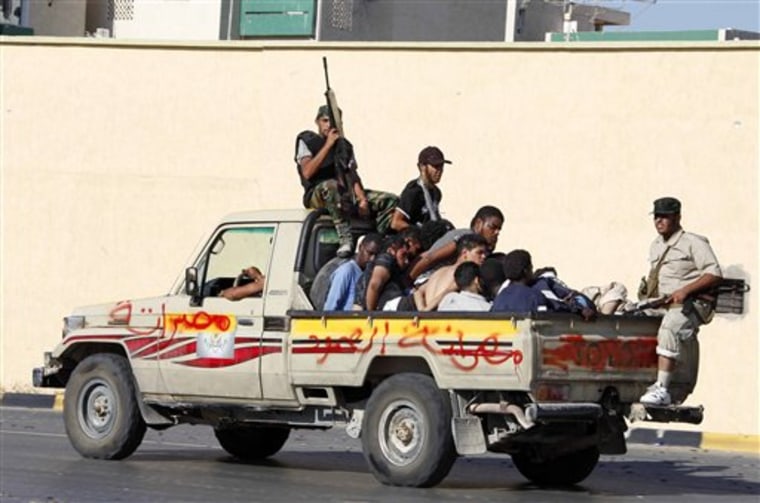Ahmed al-Said, a 46-year-old computer engineer, joined the rebels in his hometown of Misrata and fought off a bloody siege by Moammar Gadhafi's forces in what became one of the turning points of Libya's civil war. His worst memory, he says, is collecting body parts of young children and women from his city's streets.
Seething with hatred for the longtime dictator over the 2-month siege, battle-hardened Misratan fighters went on to play a key role in the capture of the capital in August. They made a daring amphibious landing on the shores of Tripoli. And days later, in their signature black pickup trucks, they blasted their way into Gadhafi's fortified Bab al-Aziziya compound, tore down an iconic monument of a fist crushing an American plane and hauled it back to Misrata as a trophy.
Two months later, it was the Misratans who finally captured Gadhafi's hometown of Sirte, the final bastion of regime loyalists.
And once they laid their hands on the fallen dictator, they did not let him go.
The Misratans hauled Gadhafi's body back to Misrata, where it was put on display on a bloody mattress in a commercial refrigerator in a shopping center. For four days running, men, women and children in the city of some 300,000 have donned surgical masks to block out the stench and formed long lines to snap pictures of themselves standing next to the rotting body.
Corpse as war trophy
By laying claim to Gadhafi's corpse as the ultimate war trophy, the Misratans are sending a clear message that they will be a force to be reckoned with in the new Libya.
"There is no doubt that because of their capabilities, the Misratans will have a bigger role" in the future, said Abdel-Basit al-Mzirig, deputy minister of justice and a Misrata native.
Misratans have flexed their muscles along the way to show that they will have a say in Libya's future and perhaps push for a leading role in the country in the post-Gadhafi era.
The have refused to accept old Libyan bank notes — which Gadhafi released in Tripoli during the civil war — despite the fact that they are accepted everywhere else in the country's west. They have also hauled suspected Gadhafi loyalists suspected of committing crimes during the siege back to Misrata, not believing other revolutionary forces will ultimately hold them accountable.
The city, Libya's third-largest and its commercial hub, has refused to budge on certain issues, chief among them the town of Tawergha south of Misrata. Used as a staging ground by Gadhafi's troops during the fight in Misrata, the town is home to black Libyans who Misratans accuse of joining the old regime's forces and committing some of the worst atrocities during the siege from March to May.
Munir al-Misrati, a 29-year-old fighter, said national reconciliation must take place, but stressed that "it is not going to happen between us and the people of Tawergha."
Misratans overran Tawergha on their way to Sirte, and virtually the entire population of the town fled ahead of the onslaught.
"They need to find a new home and the National Transitional Council should provide houses somewhere else because they can't come back to Tawergha," al-Misrati said. "I personally can't stand seeing any of them. If I did, it would be the end of his life."
Hatred runs deep
The NTC, which has been struggling to establish a functioning government since Tripoli fell to anti-Gadhafi fighters in late August, has shown little appetite for confronting Misrata over the issue. Acting Prime Minister Mahmoud Jibril said during a September visit to Misrata that the central authorities would not interfere in the city's dispute with Tawergha.
The council's authority on the ground is weak at best, and its leaders are mindful of just how deep the animosity toward Tawergha runs.
The hatred reflects just how deep the scars are from the siege of Misrata, which proved in many ways to be the turning point of the war. If Gadhafi's forces had managed to crush the city, at the time the only major rebel-held outpost in the west, the regime may well have been able to hold on to the western half of the country, with rebels running the east.
Misrata suffered immensely during the siege. There was no power, no water and food was in short supply. The city's sole lifeline was its seaport, which came under frequent attack.
Gadhafi's forces indiscriminately shelled the city, killing hundreds of civilians and overwhelming the hospitals with wounded. But through grit and guile, the city's residents fought back, turning bottles, tires and trailer trucks into tools of war to defeat tanks, rockets and professional snipers.
The ferocity of the struggle over Misrata's fate was stamped across the downtown streets — the charred hulks of tanks, the pockmarked and blown-out buildings. The main commercial boulevard and key battlefront, Tripoli Street, was left little more than a bullet-scarred wasteland, its shops and cafes shattered.
The city has avenged much of the pain and suffering Gadhafi inflicted on it.
But for al-Said, the computer engineer turned commander, Gadhafi's stay in Misrata is temporary, and he should not be buried there.
"Misrata's soil is too pure and always will be because the blood of the martyrs is in every inch of it," he said. "This filth shouldn't be buried in pure land."
___
Lucas reported from Cairo. Associated Press writer Sarah El Deeb contributed to this report from Cairo.
